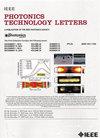FBMC-VLC系统中两种彩色编码8D调制格式的性能分析
IF 2.5
3区 工程技术
Q2 ENGINEERING, ELECTRICAL & ELECTRONIC
引用次数: 0
摘要
在本文中,提出了两种创新的彩色编码八维(8D)调制格式(即8D平面和8D立体),并在基于滤波器组的多载波可见光通信(FBMC-VLC)系统中进行了实验验证。8d平面格式是将几何壳结构组合在平面空间中形成的。而8d立体格式则是将三维星座组合在立体空间中构建而成,进一步降低了高维星座的设计复杂性。这两种格式都利用颜色编码来实现跨不同维度的联合调制。在不同的维度上利用具有不同偏振状态的符号来最大化最小欧几里得距离,减轻非线性干扰。实验结果表明,在峰峰电压和偏置电流方面,8D-stereo-FBMC比2D-FBMC、4D-FBMC和8D-plane-FBMC具有更宽的工作范围。当误码率达到$3.8\乘以10^{-3}$时,所提出的8D-stereo-FBMC方案比8D-plane-FBMC方案的数据速率提高了0.4 Gbit/s,表明该方案具有良好的非线性容错性。本文章由计算机程序翻译,如有差异,请以英文原文为准。
Performance Analysis of Two Color-Coded 8D Modulation Formats in FBMC-VLC System
In this letter, two innovative color-coded eight-dimensional (8D) modulation formats (namely 8D-plane and 8D-stereo) are proposed and experimentally validated in a filter bank multi-carrier based visible light communication (FBMC-VLC) system. The 8D-plane format is formed by combining geometric shell structures in a plane space. In contrast, 8D-stereo format is constructed by combining 3D constellations in a stereoscopic space, which further reduces the design complexity of high-dimensional constellations. Both formats utilize color coding to achieve joint modulation across different dimensions. Symbols with distinct states of polarization are utilized across various dimensions to maximize the minimum Euclidean distance and alleviate nonlinear interference. Experimental results show that in terms of peak-to-peak voltage and bias current, 8D-stereo-FBMC exhibits the broadest operational range compared with 2D-FBMC, 4D-FBMC, and 8D-plane-FBMC. When the BER meets $3.8\times 10^{-3}$ , the proposed 8D-stereo-FBMC scheme has a 0.4 Gbit/s increase in data rate compared to 8D-plane-FBMC, which indicates the remarkable tolerance to nonlinearity.
求助全文
通过发布文献求助,成功后即可免费获取论文全文。
去求助
来源期刊

IEEE Photonics Technology Letters
工程技术-工程:电子与电气
CiteScore
5.00
自引率
3.80%
发文量
404
审稿时长
2.0 months
期刊介绍:
IEEE Photonics Technology Letters addresses all aspects of the IEEE Photonics Society Constitutional Field of Interest with emphasis on photonic/lightwave components and applications, laser physics and systems and laser/electro-optics technology. Examples of subject areas for the above areas of concentration are integrated optic and optoelectronic devices, high-power laser arrays (e.g. diode, CO2), free electron lasers, solid, state lasers, laser materials'' interactions and femtosecond laser techniques. The letters journal publishes engineering, applied physics and physics oriented papers. Emphasis is on rapid publication of timely manuscripts. A goal is to provide a focal point of quality engineering-oriented papers in the electro-optics field not found in other rapid-publication journals.
 求助内容:
求助内容: 应助结果提醒方式:
应助结果提醒方式:


